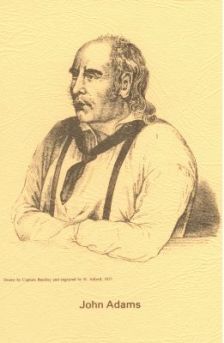 John Adams was born on 4 December 1767 at St. John’s, Hackney, London, England.1 He married Teio on 17 December 1825 at Pitcairn Island. He died on 5 March 1829 at age 61 at Pitcairn Island.
John Adams was born on 4 December 1767 at St. John’s, Hackney, London, England.1 He married Teio on 17 December 1825 at Pitcairn Island. He died on 5 March 1829 at age 61 at Pitcairn Island.
He was also known as Alexander Smith. He and Teehuteatuaonoa were associated circa 1788 at Tubuai. He and Puarei were associated circa 1790 at Pitcairn Island. He gained the rank of Able Seaman in the service of the Royal Navy, on board H.M.A.V. Bounty. He and Tinafanaea were associated at Pitcairn Island. He and Vahineatua were associated at Pitcairn Island. He and Mareva were associated at Pitcairn Island.
Adams was either from Wapping-on-Thames or Stanford Hill, St. John Hackney, Middlesex in England. His father, a lighter man and servant to Daniel Bell Cole, a merchant, drowned in the River Thames. He and 3 siblings were left orphaned, and he and 2 siblings were brought up in the poorhouse. One sibling married soon after the father’s death. It was in the poorhouse that Adams gained what little literacy he had before being tutored by Young on Pitcairn. It is also where he learned the rudiments of the liturgy of the Church of England. One brother was a waterman at Union Stairs, a ‘steady character, and wore the fire coat of London Assurance’.
He signed on board the Bounty using the assumed name of Alexander Smith. He reverted to the use of his real name (Adams) after the mutiny.
Adams belonged to that class of individuals, who, under ordinary circumstances, would likely attract public attention only when picked up by the police. Known as ‘reckless Jack’, he was not the toughest, meekest, and most nor least intelligent of the crew. Certainly not afraid to ‘go for the cutlass’, he learned survival in the streets of London.
One of the active mutineer party, he was part of the group who arrested Bligh. He was not in the leadership, but there was no question as to where his sympathies lay.
On Pitcairn, he formed a close friendship with Young, and lived as neighbours, sharing possessions and women between themselves. They had also the most even-handed attitude toward the Tahitian men. He was scarcely literate, and as he noted Young’s increasing illness, he took reading lessons each day from his companion, knowing that he would soon by responsible for the growing community. It was at Young’s death that this non-religious sailor found himself, for the first time, having to officiate at the burial services, and from that point on took his responsibilities very seriously.
Adams found himself alone among a community in which only he had an experience of the outside world. Early visitors reported him as kindly, wise, thoroughly regenerated, and a deeply religious and moral patriarch. This is likely not far from the truth. He was indeed a completely regenerated rascal – whether this was due to a deep moral direction or from simple expediency in controlling an island teeming with the young will be forever unknown. We have only his own words to judge what he did, and we have the survival of a strong, religious, vital colony that he left in his wake.1 Bligh described him as 5’5′ tall, brown complexion, brown hair, strong made, very much pitted with smallpox, and very much tattooed on body, arms, legs, and feet. He had a scar on his right foot where it was cut with a wood axe.
Children of John Adams and Vahineatua
- Dinah Adams b. c 1796, d. 18 Jan 1864
- Rachel Adams b. 1797, d. 18 Jan 1864
- Hannah Adams b. 1799, d. 27 Aug 1867
Children of John Adams and Teio
- George Adams b. 6 June 1804, d. 29 Oct 1873